Joy Neal Kidney's Blog, page 46
November 26, 2022
Review of “Leora’s Early Years” by Author Elaine Briggs
 Elaine Briggs
Elaine BriggsIn Leora’s Early Years, Joy Neal Kidney brings to life the challenges her pioneering ancestors faced and shows how the love of family brought them closer together and helped them survive.
Helping and working hard were just what everyone in the family did. I was amazed that at the young age of seven, Leora took the buggy and team of horses by herself to pick up her Grandpap from the train station. She even milked the cows. Her brothers Wayne and Merl plowed the fields at six and seven. Imagine that!
The children did chores and pitched in without complaining. Growing up through good times and hard times, Leora and her siblings developed strong values and built character.
I especially loved the stories about the one-room school and the interesting details of Leora’s family and their way of life from the late 1800s to the early 1900s.
Like Joy’s first two books, Leora’s Early Years was a pleasure to read.
Elaine Briggs has been such an encouragment to me through all three Leora books, teaching me how to convert all those old photos to 300 dpi for publishing, and just telling me to keep going, that I could see each of them through to actually birthing each book.
Elaine is the author of two books. Joe Dew: A Glorious Life is a biography of her remarkable father.
Her latest is Yes! All Can!: Increase Reading Levels in Weeks, Resolve Conflicts and Build Character, Develop Leadership with a Foreword by John Corcoran, well-known author of The Teacher Who Couldn’t Read.
Here is Elaine’s Amazon Author Page.
November 23, 2022
Leora’s Early Years: Guthrie County Roots–List of Chapters
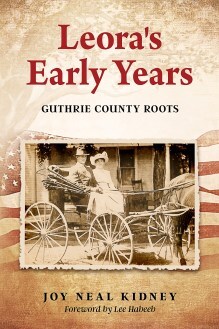
During Leora Goff’s early decades, she gathered the tenacity, optimism and hope she would need throughout her long life. When she married Clabe Wilson, they became forged into parents who would shepherd their own family through two more great eras of world and local history–the Great Depression and WWII.
I kept chapters short, in hopes that students will also enjoy reading these stories. Here are the names of the chapters in Leora’s Early Years: Guthrie County Roots:
1 Land of the Santee Sioux (1892)2 Indians Visit
3 Drought and Dust Storms
4 Pioneer Stock (1850s)
5 1860s
6 A Cow for Her Watch (1890s)
7 Iowa Again (1896)
8 Robinson Circus (1898)
9 Prairie Rural School, First “Talking Machine”
10 Horses, Chores, and the Liza Jane Train
11 Winter Entertainment and Christmas
12 Young Clabe Wilson
13 Grandpap Goff Dies, Goff Reunions (1900)
14 Decoration Day 1900
15 The Jail Escapade (1900)
16 A Baby Sister and the Guthrie County Fair (1900)
17 Two Moves, Two More Babies (1901-1902)
18 Key West, Minnesota (1903)
19 School in the Winter, and Christmas (1903)
20 Georgia Falls Down the Stairs (1904)
21 Another Circus, Another Move (1904)
22 Clabe Wilson’s Family (1903-1907)
23 Home to Iowa (1905)
24 Independence Day 1907
25 Riding a Horse to Piano Lessons (1908)
26 The 1909 Iowa State Fair
27 Clabe Wilson (1908-1909)
28 Mrs. Connrardy’s Sewing School (1910)
29 Wichita, Iowa (1911)
30 Popcorn King of Guthrie County (1912)
31 Grandpap Jordan Dies (1913)
32 Leora Meets Clabe
33 Leora Gets Married (1914)
34 Grandmother Jordan Dies, Willis’s Accident (1914)
35 Delbert Wilson Born (1915)
36 Tragedy for Cousins (1916)
37 Donald Wilson Born (1916)
38 The Great War, Clabe’s Mother Unwell (1917)
39 Death of Clabe’s Mother
40 Three Goff Brothers Drafted (1918)
41 Doris Wilson Born (1918)
42 Influenza and the Armistice (1918)
43 The Goffs’ Victorian Home (1919)
44 A Move to Stuart, Doughboys Come Home
45 The Influenza Pandemic, Stuart
46 Nineteenth Amendment (1920)
47 House Fire, Another Move (1921)
48 Stuart Nightwatchman Killed, Clabe is Hired (1921)
49 Arrests, Twins Dale and Darlene Born (1921)
50 Smallpox (1922)
51 Death of Georgia Laurayne Goff (1922)
52 Danny Wilson Born (1923)
53 Hemphill Place and Eye Surgery (1923)
54 Death of Tessie Goff (1924)
55 Clabe Bobs His Wife’s Hair
56 The Wilson School Bus (1924)
57 Life on the Farm
58 Junior Wilson Born (1925)
59 Dale and Darlene Start School (1926)
November 18, 2022
John Busbee of The Culture Buzz, Endorser for “Leora’s Early Years”
John Busbee, an effective advocate for keeping family heritage alive, edited Leora’s Early Years: Guthrie County Roots and also wrote this endorsement for the book:
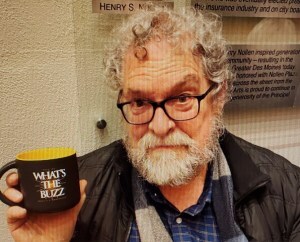
“The reasons why Leora wrote and saved what she did, capturing her life and the lives of so many in her bigger circle of family, friends and experiences, may never be fully known. What we do know is that her granddaughter, Joy Neal Kidney, has embraced the role of caretaker and scribe of these records. Kidney continues to transform these archives into a series of vibrant journeys, one book at a time, beckoning others to join her in these reflective adventures.
“Leora’s Early Years: Guthrie County Roots is the third in this irresistible series. In the wake of Leora’s bountiful passage of memorabilia, Joy’s meticulous research and gifted writing bring universal understandings alive through the magic of memoir, reminiscence and an intimate examination of everyday folks surviving in bygone times. Relevance for today’s generations radiates from each page. Each book in the Leora Series is a stand-alone. Their connective threads bind them together.
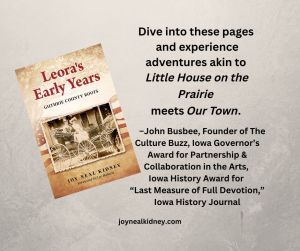 “Leora Goff Wilson instinctively knew that her saving of letters, photographs, memorabilia with her journaling would hold special meaning in a future that had not yet crystalized. She would undoubtedly be proud, albeit a little humbled, at how her treasures inspired her granddaughter Joy to reimagine their tellings for new generations. Dive into these pages and experience adventures akin to Little House on the Prairie meets Our Town.”
“Leora Goff Wilson instinctively knew that her saving of letters, photographs, memorabilia with her journaling would hold special meaning in a future that had not yet crystalized. She would undoubtedly be proud, albeit a little humbled, at how her treasures inspired her granddaughter Joy to reimagine their tellings for new generations. Dive into these pages and experience adventures akin to Little House on the Prairie meets Our Town.”
John Busbee, The Culture Buzz, Iowa Governor’s Award for Partnership & Collaboration in the Arts, Iowa History Award for “Last Measure of Full Devotion.” He is not only a writer, director, musician, actor, and radio host (Culture Buzz, KFMG-FM). John also has a weekly newsletter about anything cultural, writes for Iowa History Journal, and has a monthly column in Cityview.
The Culture Buzz website.
John Busbee also edited Leora’s Dexter Stories: The Scarcity Years of the Great Depression and wrote a review for Iowa History Journal.
November 17, 2022
The Rest of the Story of the 1942 Plymouth
McDonald Drug store in Perry, where Doris worked, sold Evening in Paris Cologne, which shoppers could sense as soon as they entered the store. Whenever any of the Wilsons were in Perry to shop or sell eggs, they honked their “party line” phone ring–long, short, long–near the store so Doris would know they were in town.
During her break she would join them in the Plymouth to read the latest letters from her three brothers who were serving by the summer of 1942.
Doris also had a little mishap when trying to back the car out of the garage on the farm. (Chapter 3 of Leora’s Letters)
1943
 Junior Wilson, leaving for the AAF. Clabe (holding grandson Richard Scar, who turned 80 last month), Junior, Leora (wearing Dale’s pilot’s wings on her coat), Darlene (Wilson) Scar. With the Plymouth, Autumn 1943, Minburn, Iowa. (Yes, Junior’s brothers kidded him about the way his jacket is buttoned.)
Junior Wilson, leaving for the AAF. Clabe (holding grandson Richard Scar, who turned 80 last month), Junior, Leora (wearing Dale’s pilot’s wings on her coat), Darlene (Wilson) Scar. With the Plymouth, Autumn 1943, Minburn, Iowa. (Yes, Junior’s brothers kidded him about the way his jacket is buttoned.)The next Wilson brother to join the military drove the car to Des Moines when he left. The next youngest brother drove it home. When Junior joined, their father drove the car home from the Capital City for the first time.
As the brothers came home on leave, the Plymouth took them to Edmonson’s Studio in Perry to have photos taken of them in uniform.
1944
Mom (Doris) returned (from Marfa, Texas, where Dad was stationed) for my birth, which was at Dexter two days before D-Day. When I was 10 days old (standard for new mothers to stay in the hospital in those days), we rode home (the Minburn farm) in the 1942 Plymouth.
With all five sons in the service, Clabe and Leora could no longer keep up with the landlord’s farm. They bought an acreage near Perry and moved there that October. Clabe cut down a crate so they could haul Leora’s chickens to the new place in the trunk of the Plymouth.
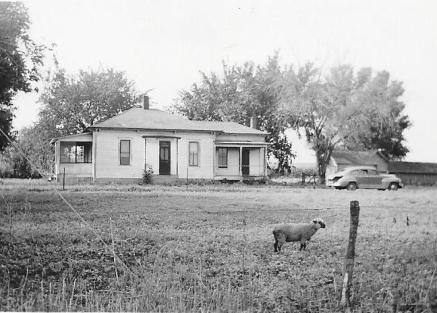 To the right is the Plymouth with the chicken crate sticking out of the trunk. House at the Perry acreage, October 1944
To the right is the Plymouth with the chicken crate sticking out of the trunk. House at the Perry acreage, October 19441945
Dad was ordered to Biggs Field, Texas, the summer of 1945. Families couldn’t be with the B-29 crews, so Mom and her toddler came back to Iowa to stay with Grandma and Grandpa (Leora and Clabe). Mom didn’t practiced driving during that time and took her driver’s test with the Plymouth.
1946
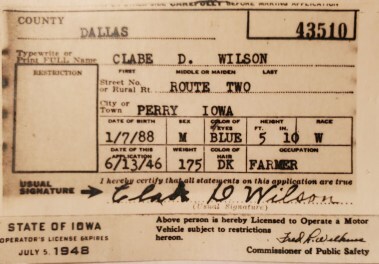 The Wilsons drove to Omaha, which was Clabe’s longest trip with the car, for Mother’s Day with Leora’s mother and other Goff relatives. After Clabe Wilson died that fall, it probably became the family car for oldest son Delbert and Evelyn. They moved back to Iowa after Junior was killed, and Leora never learned to drive.
The Wilsons drove to Omaha, which was Clabe’s longest trip with the car, for Mother’s Day with Leora’s mother and other Goff relatives. After Clabe Wilson died that fall, it probably became the family car for oldest son Delbert and Evelyn. They moved back to Iowa after Junior was killed, and Leora never learned to drive.
I wonder who eventually bought the 1942 Plymouth. There’s no one left to ask what happened to it.
1947
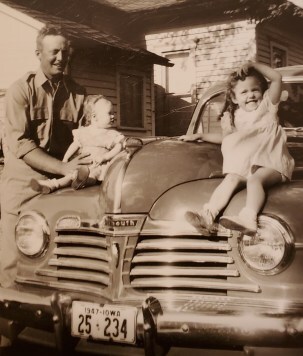 Warren Neal with daughters Gloria and Joy, with the Wilsons’ Plymouth. Acreage at Perry, 1947
Warren Neal with daughters Gloria and Joy, with the Wilsons’ Plymouth. Acreage at Perry, 1947Leora’s Letters: The Story of Love and Loss for an Iowa Family During World War II
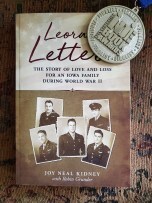
November 16, 2022
The Wilson’s 1942 Plymouth, One of the Last New Cars until after WWII
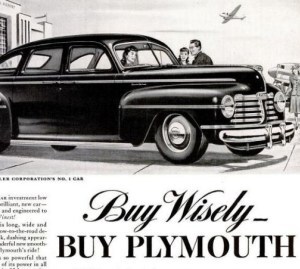
In November 1941, the Wilson sisters, Doris and Darlene, were anxious to see their brother Donald, who was home from the Navy. AWOL.
Knowing war was imminent, Don and a friend had jumped ship on the East Coast and headed for the Minburn, Iowa, farm. Don’s four brothers lived there with their folks, Clabe and Leora Wilson. Tenant farmers.
It looked like all seven Wilson siblings would be home at the same time. Their mother Leora hoped to get a family picture taken.
Doris rode the M and St L train from Perry, where she was a waitress, to Minburn. One of her brothers met her at the depot in their “old smoking Buick.” Darlene and her husband Sam arrived from their farm near Earlham. For the family photo, everyone piled into the two cars and headed north six miles to Perry, to Edmondson’s Studio.
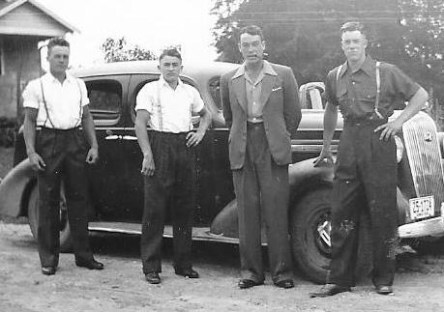 Ready to go to the Air Olympics in Des Moines, June 22, 1941. Danny, Junior, Delbert, and Dale Wilson, in front of the “smoking” Buick.
Ready to go to the Air Olympics in Des Moines, June 22, 1941. Danny, Junior, Delbert, and Dale Wilson, in front of the “smoking” Buick.While still in Perry, Donald suggested trading off their old Buick on a newer car, which they did. The Wilson brothers and their dad pooled their money and bought a brand new grey, 1942 Plymouth four-door, 95-horsepower, Special Deluxe sedan, with concealed running boards.
A few days later the expected letter arrived from the Navy: Your son is AWOL. Do you know where he is?
 Dale, Danny, and Clabe Wilson. USS Yorktown crewmen Frank ___ and Donald Wilson, headed back to the navy after hitchhiking to Iowa AWOL. Delbert Wilson on the end drove them to Des Moines in the new Plymouth.
Dale, Danny, and Clabe Wilson. USS Yorktown crewmen Frank ___ and Donald Wilson, headed back to the navy after hitchhiking to Iowa AWOL. Delbert Wilson on the end drove them to Des Moines in the new Plymouth.Soon, after snapshots in the farm driveway, handshakes, and pats on backs, Donald and Frank turned themselves in at the Navy office in Des Moines. They were sent to the brig at the Great Lakes Naval Training Station in Illinois. While they were there, Pearl Harbor (where their ship had been based a year earlier) was attacked by the Japanese. The young navymen were hustled back aboard their aircraft carrier on the East Coast. Both lost rank and pay, but were soon in the thick of the war in the Pacific.
Meanwhile, at home in Iowa, the Wilsons didn’t know it would be the last photo taken of the family, and that they’d just purchased one of the last new automobiles available until after the war.
Leora’s Letters: The Story of Love and Loss for an Iowa Family During World War II
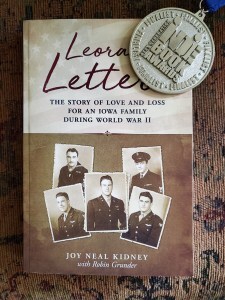
November 14, 2022
Annual Thanksgiving Dexter-Earlham Game Next Thursday [1931?]
More about the annual Thanksgiving Dexter-Earlham football rivalry, welcome excitement during the Great Depression:
“Dopesters At Sea In Efforts To Accurately Compare Qualities of The Two Teams.”
 Trophy for the annual Dexter-Earlham Thanksgiving rivalry is now housed in the Earlham Community School, Earlham, Iowa. It was played every Thanksgiving from 1912-1944. (Thanks to Cody Thompson for the photo!)
Trophy for the annual Dexter-Earlham Thanksgiving rivalry is now housed in the Earlham Community School, Earlham, Iowa. It was played every Thanksgiving from 1912-1944. (Thanks to Cody Thompson for the photo!)“The game is the annual Thanksgiving Day clash between the traditional adversaries–Dexter and Earlham.
“The place is the Dexter Athletic Field.
“The hour is exactly 2:30 o’clock, CST
“The temperature–of the crowd–it will be 180 in the shade.
“Who will win? Who knows?
“If the teams are judged on a basis of consistent playing, then Earlham wins. But if the teams are judged on their ability to play, then Dexter wins.
“The writer has watched both teams. Earlham plays a steady, consistent game from start to finish, ready for every break, ready for every falter in its opposition. Earlham plays just as strong and just as hard in the last minute as in the first–I’ve never seen the Earlham boys waver, not even when it appeared they were about to be overwhelmed, neither when they were riding high, wide and handsome over their opposition. They are in there all the time–and that’s how they make it tough for any team against them.
“Now, Dexter is erratic. For a few minutes they play football that would credit a big college–then they are just as like as not to act like a bunch of kindergarten children. They’ve played that way all this season. Why? We opine that the blame is equally distributed between the team and the coach. Some fans claim [cannot read] erraticisms are because of the method of substitutions, which come anytime and ofttimes lacking the purpose of strengthening the team. It is said that many time not even the team understands why men are jerked and other substituted. Resentment and bewilderment are generated in the team ranks–the coach becomes taciturn and morose–and the morale of the players is shattered. Of course both team and coach sbould be above personalities. Should it be that nothing untoward happens to smash Dexter’s morale, then Dexter will beat Earlham–otherwise Earlham wins.
“This annual conflict is an institution. The crowd will be great. The price of admission is 35 cents for other than students–25 cents for all students.”
The Dexter Sentinel, Volume XLII, addressed to Clabe Wilson, subscription expired Sept. ’32, so perhaps 1931.
November 10, 2022
November 9, 2022
His Compelling Generosity
This kindly bearded phizog belongs to the gentleman who radiated the most winsome generosity ever, and one I hadn’t met in person.
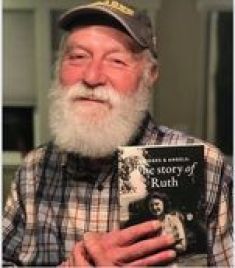 Photojournalist, author, teacher, generous friend, David LaBelle
Photojournalist, author, teacher, generous friend, David LaBelleIt’s no surprise to his family, friends, and students that Dave LaBelle would drive 450 miles in one day just to attend the book talk of a social media friend.
We’d “met” a couple of years earlier through an online writers’ conference, where he was a presenter. Afterwards I contacted him about his novel, Bridges & Angels: The Story of Ruth. I read and reviewed it. He read my first book, Leora’s Letters.
Both books are family stories, both deal with horrendous losses. We connected because of those stories.
A year later I asked if he’d share his story with Our American Stories, which he readily agreed to. (It runs about 15 minutes.)
He’s also a photojournalist and has taught at the university level. He lugs a black camera with big lensy things on the front. A cellphone camera is my style, so I didn’t expect to enjoy his books about photography. But one promised that I wouldn’t need to know about f-stops and such, called “I don’t want to know all the technical stuff. . . I just want to shoot pictures.” Perfect. And the writing is delightful.
Recently Dave read Leora’s Early Years: Guthrie County Roots. The day before I was to give a book talk about it in Guthrie Center, he sent an email with his compelling reflections about it.
 “Here’s looking at us,” he captioned this one
“Here’s looking at us,” he captioned this oneWell, you can’t miss a tall man with a cap and a white beard filling the doorway of the library in Guthrie Center. I was surprised, and yet not, having picked up on his genuine character through social media. Afterward Dave mingled with the audience, sharing some of his own books. His surprise visit enhanced an already-perfect day.
God blesses us through other humans, their generosity. May Dave’s serendipitous visit always remind me to radiate generosity to others.
Here’s David LaBelle’s website. You may also order books and prints from his website, and sign up for workshops. A beautiful 15-minute video about his work, “connecting the eye and the heart.”
My review of Bridges & Angels.
 Dave photographed my handsome “support staff.”
Dave photographed my handsome “support staff.”
November 7, 2022
“Thanksgiving Day As Observed In This Community” [Dexter, Iowa, 1920s]
There’s no date on this one, but among former Dexter residents who returned to watch the game was Keith Neal, who was the older brother of Kenneth and M.M. Keith’s last child born in Dexter was Merritt Winsell (named for the first Dexter boy killed in WWI, but called “Bud”) in 1920. His next children, Mary Marjorie (named for M.M. Neal’s twin sister) was born in Des Moines in 1922 (as were the rest of Keith and Cora’s 10 children).
So, after 1922, Dexter newspaper:
“Morning Busy, Noon Very Full, Afternoon Exciting, and Evening Very Peaceful.
“Thanksgiving Day in the morning. Sun came up bright and warming after several days of cold weather. Everyone woke to find nature adding its bit to the general spirit of holiday. Those, who had not arrived the night before, came in the morning to be on deck at the various family dinners in the community. Mothers stuffed chickens, ducks or turkeys, chucked them in the oven, and started all other good things for the huge Thanksgiving dinners. Last minute shopping was done; tables were set and extra leaves added to the dining room tables; everyone was very, very busy. Shortly before ten o’clock, like Pilgrims of old in modern dress, folk wended their way to church to give public thanks to the giver of all good gifts. Union services were held by the Presbyterians and Methodists in the Presbyterian church, and the Lutherans held services in their church.
“Thanksgiving Day at noon.
“Everyone sat down to overladen tables, with all the children home to take in mother’s stuffed turkey and cranberry sauce. From the supplies of the more fortunate had come chickens and the trimmings to spread Thanksgiving cheer in other less favored homes, so that nowhere in this community could there be a dinnerless Thanksgiving Day. And still the sun shone and the day was fair. And everyone ate too much.
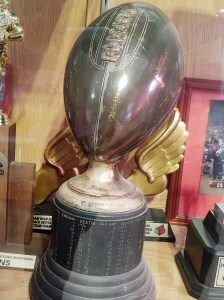 Trophy for the annual Dexter-Earlham Thanksgiving rivalry is now housed in the Earlham Community School, Earlham, Iowa. It was played every Thanksgiving from 1912-1944. (Thanks to Cody Thompson for the photo!)
Trophy for the annual Dexter-Earlham Thanksgiving rivalry is now housed in the Earlham Community School, Earlham, Iowa. It was played every Thanksgiving from 1912-1944. (Thanks to Cody Thompson for the photo!)“Thanksgiving Day in the afternoon. Nearly 2:30. Everyone grabbed coats and hats and galoshes to go to the big football game held in Dexter this year. The unusually fine weather brought out a large crowd of Dexter and Earlham fans. Fences went down on both sides, as per usual, from the pushing, cheering, excited rooters, Earlham and Dexter bands played. Everybody yelled. Folk were there who had not been back to see a Thanksgiving game for more years than they cared to remember. Saw Fred Wolfinger, who had decided at his dinner table in Des Moines that he wanted to see Dexter and Earlham play again and whom we heard say as he left the field, “Good game. Glad we came.” Also saw Homer Bosley, Bill Vogel, Howard Calfee, Carl Hodson, Albert Gilleland, Keith Neal, Dewey McMurray, and other former Dexter residents. Fine old spirit of football rivalry pervaded the crowds with none of the old animosity. Dexter won, 6-0, by good straight football. Great game! Great deal of excitement.
“Thanksgiving Day in the evening. Plenty left over from dinner for the evening meal. Some visitors left after the game, others stayed for the weekend with the home folk. Fine edge of the afternoon hilarity and excitement worn off and a feeling of peace settled over the community. Lighted windows showed small family groups gathered about the fire, reading, visiting, being thankful for each other and the good things of the day. The end of a perfect Thanksgiving Day.”
November 4, 2022
Arvid Huisman, Author and former Newspaper Editor, Endorser of “Leora’s Early Years”
 “While I am not related to the author of Leora’s Early Years, I feel like a long-lost cousin after reading her books. Especially in this latest book, Joy Kidney’s weaving of her families’ stories into a colorful tapestry that can help the reader appreciate their own families’ stories. Leora’s Early Years is a heartwarming narrative of real people who lived real lives in real places that we can find on a map. We of the 21st century have much to learn from the lives of Joy’s family of the 19th and early-20th centuries.”
“While I am not related to the author of Leora’s Early Years, I feel like a long-lost cousin after reading her books. Especially in this latest book, Joy Kidney’s weaving of her families’ stories into a colorful tapestry that can help the reader appreciate their own families’ stories. Leora’s Early Years is a heartwarming narrative of real people who lived real lives in real places that we can find on a map. We of the 21st century have much to learn from the lives of Joy’s family of the 19th and early-20th centuries.”
 Arvid Huisman, former newspaper publisher, author of More Country Roads, an anthology selected from more than 900 of his delightful Country Road columns, which thankfully continue today in Iowa History Journal.
Arvid Huisman, former newspaper publisher, author of More Country Roads, an anthology selected from more than 900 of his delightful Country Road columns, which thankfully continue today in Iowa History Journal.
His compelling story in the latest Iowa History Journal (Nov./Dec. 2022) is “The greatest of these is love: Sharing my Christmas snapshots.”
Retired as Director of Development, Community Relations and Media Relations for The Salvation Army in Des Moines, Arvid has had hundreds of speaking engagements and still enjoys giving programs.
Arvid doesn’t have a website, but here’s an interesting interview from a while back with Aaron Putze.




